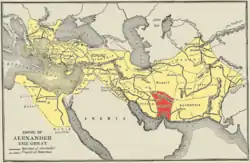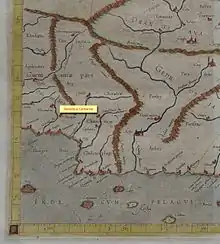Alexandria Carmania
Alexandria Carmania (Greek: Αλεξάνδρεια η εν Καρμανία, Alexandreia hē en Karmania) was one of the seventy-plus cities founded or renamed by Alexander the Great.[1][2][3][4][5][6][7]
Alexandria Carmania
Αλεξάνδρεια η εν Καρμανία | |
|---|---|
City | |
 The area of Carmania where the Alexandria Carmania was located, noted with red colour on the map of the Empire of Alexander the Great | |
| Country | Iran |
| Founded by | Alexander the Great |
The town was founded by Alexander in January 324 BC after his army had reunited with Nearchus and his men who had beached their boats near the mouth of the Minab River.[8][9][10]
Location
The exact site of the city in Carmania is still unknown but several locations have been proposed:
- The most commonly cited location is the village of Gulashkird, Iran[11] (Lat. 27° 56' 57"N Long. 57° 17' 57"E)
- The unexplored ruins to the north and northwest of Gulishkird.[12]

- The village of Gav Koshi nearby to the east of Gulishkird has also been popular.
- Sykes says it was in Rudbar 5km north of Gulishkird, based on surface finds of Greek pottery he made in that location.[13]
- A less likely option is the village of Sharh-i Dakyanus (Town of the emperor Decius) near Jiroft, Iran.[14][15][16][17]
- Sites at Sirjan and Tepe Yahya have also been postulated.[18]
- Fraser, taking a typically conservative position thinks that Alexandria in Carmainai never existed.[19]
- The 1569 world map of Gerardus Mercator, taken from Ptolemy's second century world map, shows Alexandria Carmania further to the west on the Salarus River, in the arid area north of the modern town of Haregī, Iran.
The main contenders are all within a few kilometres of each other and that area would seem a logical one. Provided with reliable water from the Minab river, the location was on the convergence of the main passes from Afghanistan, the route into Gedrosia and had good access to the nearby Indian Ocean ports at Hormosia. The location would also provide control of the arable parts of Carmania.
The city still existed in the medieval period being known as Camadi, when Marco Polo visited.[20] If Galashkird is the now lost city it was described by Arab geographer Mukaddasi who described it as "a strongly fortified town with a castle Kushah," and lush orchards and fields supported by extensive qanat irrigation.
References
- Getzel M. Cohen, The Hellenistic Settlements in the East from Armenia and Mesopotamia, University of California Press 2013 page 200
- William Woodthorpe Tarn, The Greeks in Bactria and India (Cambridge University Press, 2010) p481.
- P. Leriche, “Alexandria,”, Encyclopædia Iranica, I/8, pp. 830-831..
- J. G. Droysen, Geschichte des Hellenismus, (1878).
- V. Tscherikower, Die hellenistischen Städtegrunden, (1927).
- E. Badian, Alexander the Great, (1950).
- G. A. Koshelenko, Grecheskiĭ polis na ellinisticheskom vostoke, (1979.)
- Ammianus Marcellinus XXIII 48
- Ptolemy VI 8 14
- Pliny, Natural History 6. 107 110
- G. Le Strange, The Lands of the Eastern Caliphate, Cambridge University Press 2011. page 317
- Lewis Vance Cummings, Alexander the Great (Grove Press, 2004)page 402 p402
- Sir Percy Molesworth Sykes, A History of Exploration from the Earliest Times to the Present Day, Taylor & Francis, 1949
- I. Gershevitch, The Cambridge History of Iran, Volume 2 Cambridge University Press 1985 page 248.
- Cook, J. M., The Persian Empire, (Book Club Associates, London, 1983)
- Ala-ad-Din Ata Malik Juvaini, The History of the World Conqueror. (Harvard University Press, 1958) page477.
- William Vincent, Samuel Horsley, William Wales, ----- de La Rochette, The Voyage of Nearchus from the Indus to the Euphrates: Collected from the Original Journal Preserved by Arrian, and Illustrated by Authorities Ancient and Modern (T. Cadell (jun.) and W. Davies, 1797) page 304
- Alexandria at Encyclopedia Iranica.
- Fraser, P. M., Cities of Alexander the Great, (Cambridge University Press, Cambridge, 1996)
- The travels of Marco Polo vol 1, chapter16.